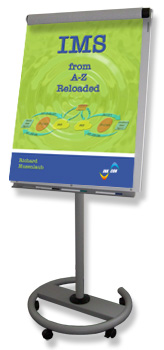 IMS from A-Z - Reloaded
IMS from A-Z - Reloaded
[2-day course, Euro 2,350.- (net) per participant]
 Introduction to the IMS
Introduction to the IMS

- Commercial & Technical Reasons to introduce an IMS
- What are the driving Forces behind the NGN-Hype?
- Next Generation Networks and their Components
- The IP-Multimedia Subsystem
- IMS-based Service Overview
- Why should one go for an IMS-based-Solution?
- How is an IMS embedded into the overall Network Architecture
- Performance Comparison between Different IP-CAN’s
- Mobility Issues
- Involved Standards Organizations
- 3GPP
- 3GPP2
- TISPAN
- CableLabs
- DSL-Forum
- Feature Summary 3GPP Releases 8 to 10
- Overview of the IMS-Network Architecture
- How is an IMS structured internally
- Mobile Telecom Operator
- CableTV Operator
- ISP
- Centralized and Split Approaches for the IMS Implementation
- Triple Play and Quadruple Play
- Initial Situation
- Cable-TV Operators
- Telecom Operators
- Internet Service Provider - Triple Play
- Quadruple Play
- Initial Situation
- The Service Perspective of the IMS
- Service Types and Service Enablers
- Conversational Services
- Two-Party Audio Calls
- Multiparty Audio Calls
- Call-Related Supplementary Services
- Multimedia Calls
- Non-Real Time Messaging
- Instant Messaging
- Chat Rooms
- Audiovisual Entertainment Services
- TV Broadcast
- Radio Broadcast
- Video on Demand (VoD)
- Audio on Demand (AoD)
- Gaming
- Service Enablers
- Fixed Mobile Convergence (FMC)
- Presence
- Where are we with IMS today?
- … and why is LTE becoming a driver for IMS?
- IMS Deployment by 2010
- Planned Network Evolutions (Europe, North America)
 IMS Protocol Overview
IMS Protocol Overview
- An Overview
- Protocols of the IMS (Perspective of User Agent)
- Protocols within the IMS-Control Plane
- Protocols within the IMS-User Plane
- SIP and SIP-Operation
- Scope of SIP
- Session Setup Example through SIP
- Some SIP-Terminologies
- Session Description Protocol
- Introduction to other important IMS-related Protocols
- Introduction to the DIAMETER Protocol
- IMS-specific Amendments to DIAMETER Protocol
- RTP / RTCP
- The H.248- / MEGACO-Protocol
- Context and Terminations
- Example of Media Gateway Operation through H.248 - DNS-Queries in the IMS-Environment
- ENUM
- IPsec
- IPsec in Tunnel Mode, IPsec in Transport Mode
- Introduction to the DIAMETER Protocol
 Inside the IMS and Service Examples
Inside the IMS and Service Examples
- Logical Elements within the IMS-Environment
- Typical User Agents of the IMS
- IMS related User Identities
- Server Types (generic)
- Special Server Types (generic)
- Operation of Registrars
- Detailed Consideration of SBC and B2BUA
- Example: VoD for a Mobile Client with limited Access Rates
- Example: SBC for Traffic Inspection - Operation of Event Servers
- Generic Servers vs 3GPP IMS Server Types
- Detailed Description of the IMS-Network Architecture
- P-CSCF Tasks & Functions
- Characteristics - I-CSCF-Tasks & Functions
- Characteristics of I-CSCF - S-CSCF-Tasks & Functions
- Characteristics of S-CSCF - BGCF-Tasks & Functions
- Characteristics of BGCF - MGCF and MGW-Tasks & Functions
- Characteristics of MGCF - Characteristics of IMS-MGW
- MRF-Tasks & Functions
- Characteristics of MRFC
- Characteristics of MRFP
- P-CSCF Tasks & Functions
- IMS Service Examples
- See what I see – Technical Realization
- Intelligent Address Book – Technical Realization
- IMS-Originating Voice Call – Technical Realization
- IMS-Terminating Voice Call – Technical Realization
- Use Case of the BGCF
 IMS-Issues and their Resolution
IMS-Issues and their Resolution
- Service Delivery Obstacles
- Different possibilities for the UA to find “its” Registrar
- Security related Obstacles
- IMS-Access from different types of Access Networks
- IMS-Registration with Authentication
- IMS-Registration with Authentication (continued)
- QoS-Awareness of Intermediate Entities
- Real-time Capability
- IPv4/ IPv6 Interworking
- Is there any NAT/NAPT or even NAT/NAPT Cascading between UA and P- CSCF?
 Case Study: A deployed IMS-Implementation
Case Study: A deployed IMS-Implementation
- Architectural Overview
- Overall Network Design
- Physical Topology Design
- Customer Premises with WIMAX Access
- Summary of the Main Components of Network Architecture
- Distribution of IMS-Core Network Entities
- Physical Layouts of IMS-Hardware
- CSCF Cabinet-Front & Rear View
- HSS and SBC - Front & Rear View
- AS’s hosted on SUN Boxes - Front & Rear View
v2.2
ℹ️ Try out the updated search below!
Search:
More Info:
General Information about this course
Schedule of this training course
Buy this book
Our Training-Catalog
GSM Training Courses
(E)GPRS Training Courses
3G Training Courses
Multimedia & TCP/IP Training Courses
SS7 Protocol Stack Training Courses
Transmission & Access Technologies Related Courses
Bootcamps
